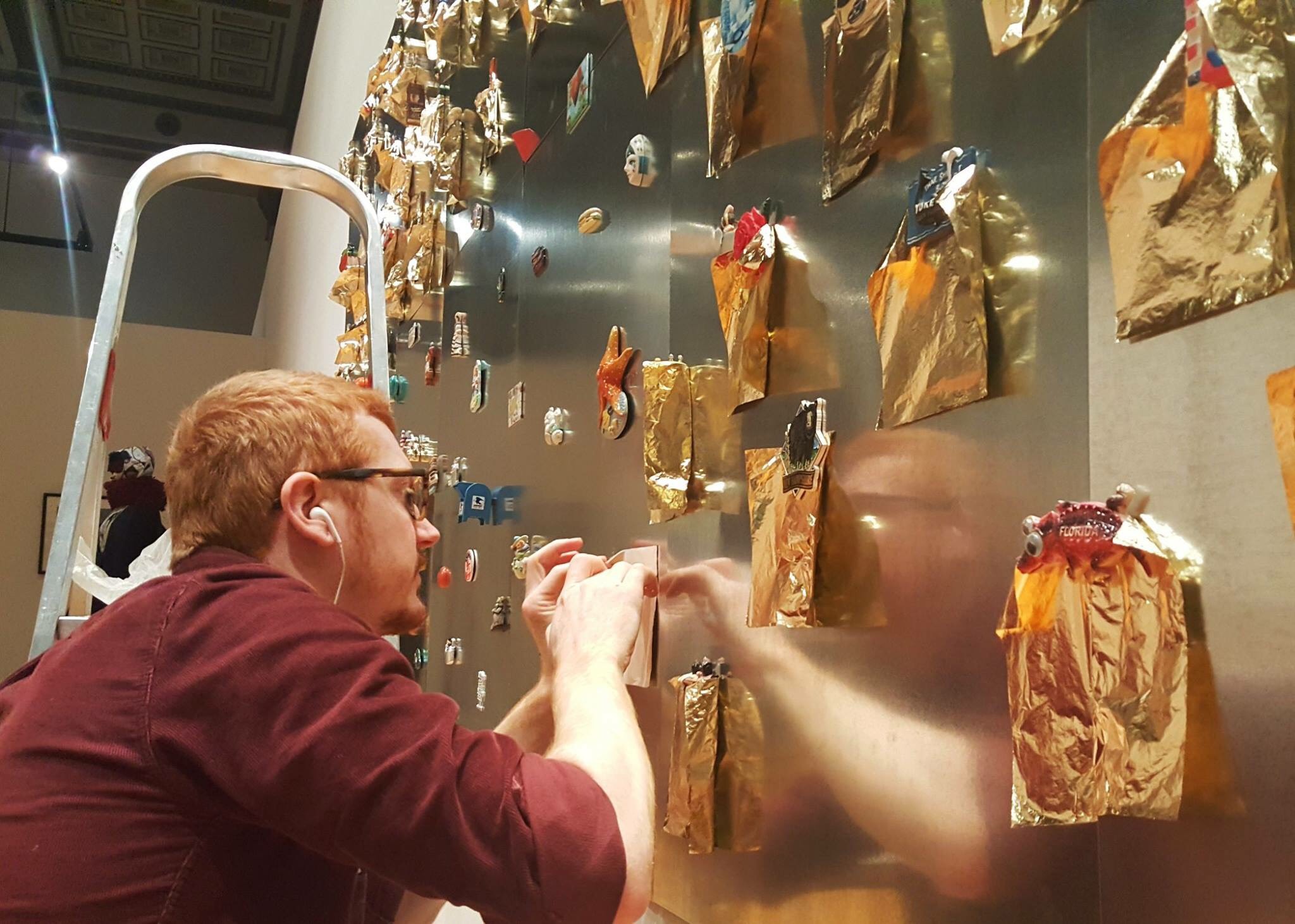The exhibit is called “50×50 Invitational / The Subject is Chicago: People, Places, Possibilities.” The words in the title tug on a range of thematic threads, leaving a viewer of the exhibit without a concrete summary of what they’re about to see. Visitors walk into the Chicago Cultural Center with only a vague conception of the works’ source—Chicago—and the unobtrusive guidance of a few posters hanging on the wall near the entrance. They include a colored map of the city divided into its fifty wards, along with the corresponding names of fifty artists or collaborative teams. Beyond that, the viewer is set free; there is little linear progression to the exhibit or organization in terms of theme within the space. Photographs of children on a street hang alongside collage-like paintings. There’s a video of schoolchildren singing “America the Beautiful,” a horn on a chair and a device that plays accompanying sound, and a red and gold rug that cohabitates peacefully with a neighboring series of lake photographs. This is not an exhibition that’s already been pieced together a certain way; its presentation asks us to be open-minded in our viewing and interpretation.
A group of artists and curators selected works for the exhibition according to a multi-dimensional and dynamic set of criteria, according to exhibit juror Miguel Aguilar, who worked with five other Chicagoans to recruit and select art from local artists. Their goal was to represent diverse walks of life, which meant focusing upon longtime residents of the city, many of whom had little previous exhibition experience. Aguilar, a teacher in the Art History, Theory, and Criticism department of the School of the Art Institute of Chicago, said this project opens up a dialogue about conventional notions of artistry and the privilege associated with being an artist. “It challenged all of us to think about how we think of ourselves as curators, but also [challenged] the notion of curating to the [art historical] canon or for the canon. I think because this was a huge conceptual undertaking around how to be as inclusive as possible, [we thought] of everybody having the possibility of being an artist and not sort of being a closed-off, exclusive setting.”
Aguilar posited these conversations as healthy, and said that sensitivity to diverse experience enriched the exhibit. The finished product is a celebration of the small moments of everyday life, and an investigation into the ability of these moments to tell a broader story about life in Chicago. When asked about the intended takeaway for the viewer, Aguilar said: “There’s a fuller breadth to life in Chicago. I think there’s a good range of narratives and themes in the work that works against a lot of Chicago stereotypes for someone who might be visiting or might not be familiar with a lot of the different areas of the city. So, we wanted to really just accurately portray that there’s so many different facets and so many more considerations and celebrations of living in Chicago.”

Each piece of artwork speaks differently, and representations of the South Side are no exception in crossing boundaries of form, message, and style. An installation piece by 3rd Ward residents Paola Aguirre and Sara Pooley titled “Closed Chicago Public Schools” evenly spaces out rectangular yellow boxes on an expanse of wall. Each box bears the name of a school in stark black type. An accompanying poster provides a map of the schools and offers background for the display, reading: “Since 2013, over forty Chicago Public Schools have closed due to budget cuts, under-enrollment and low performance. This group of buildings average 68,000 square feet of indoor space per closed school—this leaves more than three million square feet of existing space to be reimagined plus hundreds of acres of outdoor space.” The display is commemorative and constructive; in the artwork of locals, a nuanced understanding and representation of complex dynamics within the city accompanies a plain hope. Other South Side pieces access the poetry in the everyday: in 6th Ward resident Rose Blouin’s 2012 black-and-white photograph “Anointed,” a young boy holds an opened plastic water bottle upside down above his head. Water runs in rivulets down his face. In his closed eyes, the soft light on his cheekbones, and the simple title, there is a sense of reverence for a moment that could occur on any Chicago summer day and pass without artistic recognition.
Aguilar believes that the diverse array of artistic moments is ultimately daring, even revolutionary. “It seemed like the submissions from the South Side tended to either celebrate or investigate culture a little deeper and either through ethnicity or tradition or new culture,” he said. “Almost like recasting a new form of Americana. The art of “50×50 / Invitational” does not ask to be read or interpreted in terms of thematic sequence or story, it asks only to be seen. In its inclusion of a diverse range of art from Chicago’s fifty wards, artistic styles and forms intertwine—there’s an abstraction of the concept of narrative to its most nebulous degree, and the viewer leaves with more questions than answers. But maybe that’s the point.
“50×50 Invitational / The Subject is Chicago” is on display at the Chicago Cultural Center downtown through April 9.
Did you like this article? Support local journalism by donating to South Side Weekly today.


supar…………………….supar